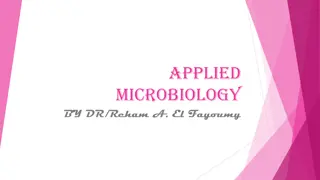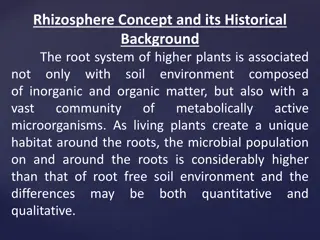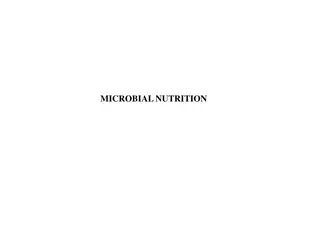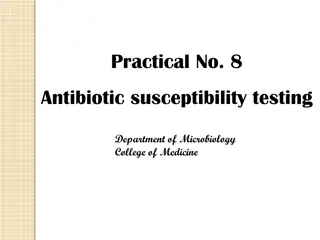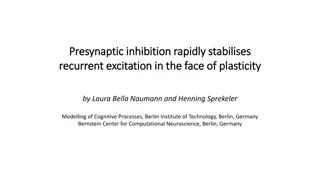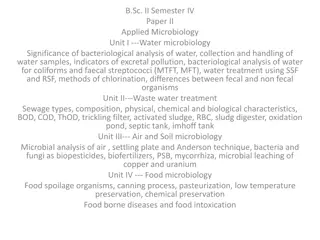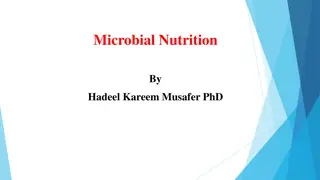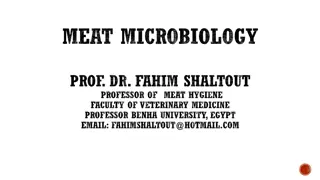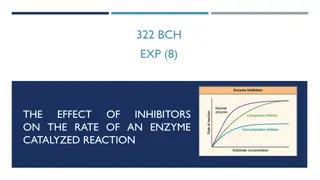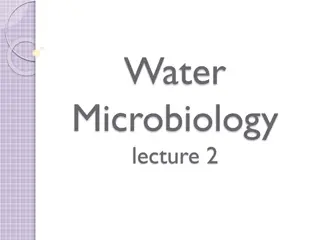Understanding Microbial Growth Inhibition in Medical Microbiology
Exploring the concepts of microbicidal vs. microbistatic processes, sterilization vs. disinfection methods, pasteurization, sanitization, and various physical methods used to inhibit microbial growth in medical settings. Heat treatment is highlighted as a common and effective method for sterilization due to its practicality and efficiency.
Download Presentation

Please find below an Image/Link to download the presentation.
The content on the website is provided AS IS for your information and personal use only. It may not be sold, licensed, or shared on other websites without obtaining consent from the author. Download presentation by click this link. If you encounter any issues during the download, it is possible that the publisher has removed the file from their server.
E N D
Presentation Transcript
Inhibiting Microbial Growth in vitro CLS 212: Medical Microbiology
Microbicidal or Microbistatic? Microbicidal Microbicidal is the process or an agent that kills the microorganism. The suffix -cidal or cide means ''killing''. Microbistatic Microbistatic is the process or an agent that inhibits the growth and reproduction of the microorganism. The suffix -static or state means ''inhibiting or stopping''.
Sterilization or Disinfection? Sterilization Sterilization is the complete destruction of all forms of microbial life including bacteria, viruses, fungi, parasites, and spores. Disinfection Disinfection is reducing or eliminating the number of pathogenic microorganisms to the point where they no longer cause disease. But this method does not affect spores.
Pasteurization and Sanitization Pasteurization Is a disinfecting method used to eliminate pathogens from liquids e.g. milk, juice,.. Sanitization Sanitization is the use of chemical agents on food-handling equipment to meet public health standards and minimize chances of disease transmission e.g. use of hot water & soap in cleaning restaurants.
STERILIZATION AND DISINFECTION METHODS Methods used to destroy or inhibit microorganisms are either physical or chemical, and sometimes both types are used.
Physical Methods They are commonly used in hospitals, clinics, and laboratories. Physical methods include: 1. Heat. 2. Cold. 3. Desiccation. 4. Radiation. 5. Ultrasonic waves. 6. Filtration. 7. Gaseous atmosphere.
I- HEAT Heat is considered the most common method for sterilization because it is practical, efficient, and inexpensive. Heat kills microorganisms by denaturing their enzymes and other proteins. There are three methods of sterilization or disinfection by heat: dry heat moist heat autoclave.
I- HEAT 1. Dry Heat An effective way to sterilize metals, glassware, some powders, oils, and waxes. 1. Hot Air Oven: It is done in a 160-165 C oven for 2hours or in 170- 180 C oven for 1hour. 2. Burning (incineration): Is used to destroy contaminated disposable materials. 3. Direct Flame: Bunsen burner or electrical heating device is used to sterile wire loops and forceps used in the laboratory.
I- HEAT Dry heat Oven Bunsen Burner Electric Bunsen
I- HEAT 2. Moist Heat Is used to disinfect syringes, needles, and simple instruments by boiling (100 C) for 30 minutes. Boiling is not always effective as spores, like Mycobacteria, and some viruses are not affected.
I- HEAT 3. Autoclave An autoclave is a large metal chamber that uses steam under pressure for sterilization (like the pressure cooker). Autoclaving is done at 121.5 C and 15psi pressure for 20 minutes. An autoclave tape or strip (commercially available) is used to ensure proper functioning.
II- Cold 1. Freezing (below zero) Freezing will greatly slow the metabolic activities of microorganisms leading to inhibition of their growth. 2. Refrigeration (4 C) Refrigeration will slightly affect the metabolic activities of most microorganisms but it would not completely inhibit growth.
Slow Freezing is the most effective way as ice crystals that forms may rapture the cell membrane and cell wall of microbes. CAUSION: Thawing and refreezing of food will allow the bacteria and its spores to resume growing.
III- Desiccation (Drying) Many microorganisms stay viable even after drying but they cannot reproduce i.e. desiccation will inhibit the growth of microorganisms. When suitable moist and nutrient rich environment is available, the microorganism will grow rapidly. It is a method mainly used for food preservation.
IV- Radiation There are three different types of radiation that can be used to control microorganisms: 1. Ionizing radiation. 2. Ultraviolet radiation. 3. Microwave radiation.
Electromagnetic spectrum
A portion of the electromagnetic spectrum. Wavelength is given in micrometres, m: 1 m = 10 6m. Note that the wavelength changes by a factor of 10 for each division along the top scale, so this is a logarithmic scale.
IV- Radiation 1. Ionizing Radiation Gamma rays, X-rays, and Beta rays from radioactive materials have short wavelengths (less than 1 nanometer). Cause death or mutations in microorganisms as they damage the DNA and proteins. Used to sterilize pharmaceuticals, disposable medical supplies, heat-sensitive surgical equipment. Food industry is interested in using ionizing radiation e.g. chicken. Disadvantages: Penetrates human tissues and may cause genetic mutations in humans and cancer.
2. Ultraviolet light (Non-ionizing Radiation) Wavelength is longer than 1 nanometer. Damages DNA which cause mutations or death. Most commonly used as UV-lamps that sterilize operating rooms, nurseries, cafeterias,.. Disadvantages: Damages skin, eyes and does not penetrate paper, glass, and cloth.
IV- Radiation 3. Microwave Radiation Wavelength ranges from 1mm to 1m. May kill microbial cells in moist foods but not spores.
V- Ultrasonic Waves Used for cleaning and sterilizing delicate equipments. Ultrasonic cleaners consist of water tanks, were short sound waves pass through, removing organic debris from equipments.
VI- Filtration Filtration is the removal of microbes by passage of a liquid or gas through a screen like material with small pores. Filters of various pore sizes can be used. Used to sterilize heat sensitive materials like vaccines, enzymes, antibiotics, and some culture media. High Efficiency Particulate Air Filters (HEPA): Used in operating rooms and burn units to remove bacteria from air.
VI- Filtration HEPA
VII- Gaseous Atmosphere In rare cases, changing the atmosphere can be used as a way to inhibit the growth of microorganisms. Aerobes and microaerophiles can be killed by placing them in oxygen-free atmosphere. Whereas, anaerobes can be killed by placing them in oxygen atmosphere.
Chemical Methods Disinfectants A disinfectant is a chemical agent that is used to inhibit microbial growth on inanimate objects, surfaces, and floors. Antiseptics An antiseptic is a chemical agent that is used to inhibit microbial growth on human skin and mucous membranes.
Most commonly used Disinfectants 1. Soaps and detergents, alcohols, and phenolic compounds: destroy microbial cell membranes e.g. Dettol. 2. Formaldehydes, hydrogen peroxide, halogens, and salts of heavy metals: destroy enzymes and structural proteins e.g. Bleach, Clorox. 3. Chlorine, ozone, iodine: attach nucleic acids.
Most commonly used Antiseptics 1. Iodophor: used as skin antiseptic in surgery. 2. Alcohol: used on skin before needle pricking. 3. Mercurochrome: used to disinfect skin wounds.


